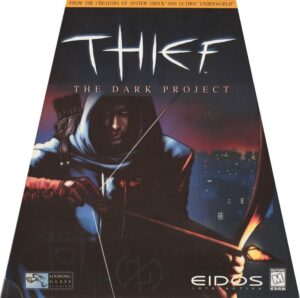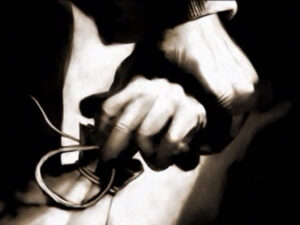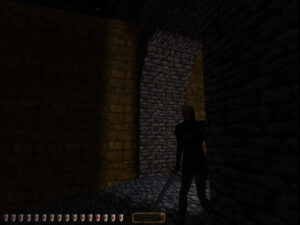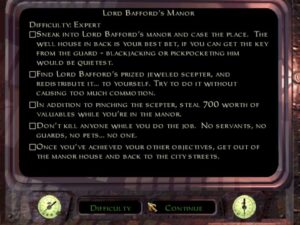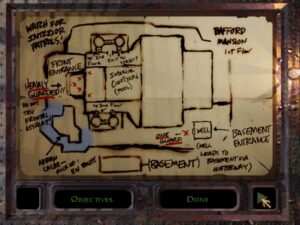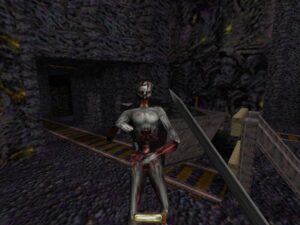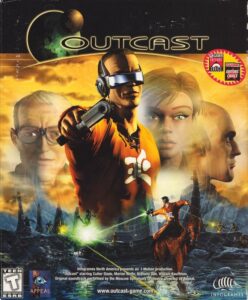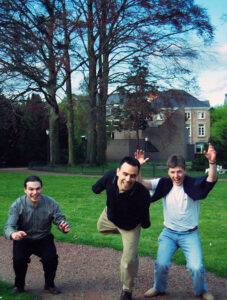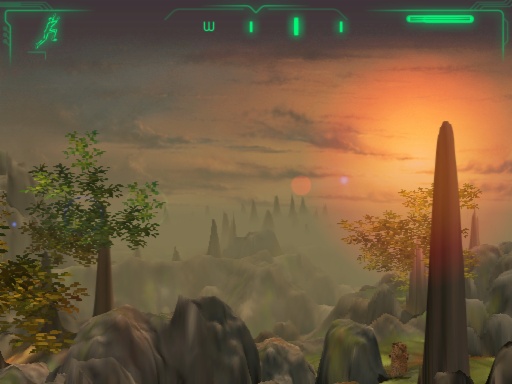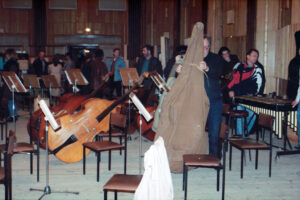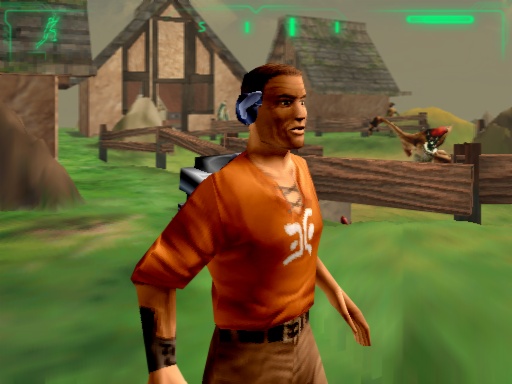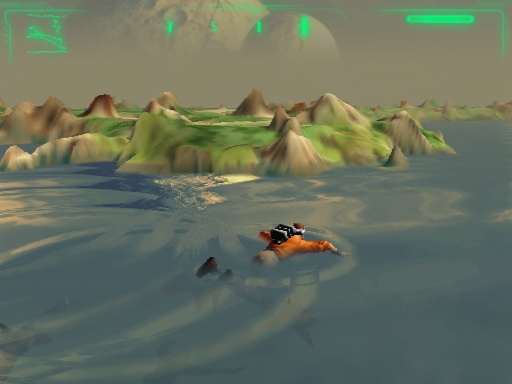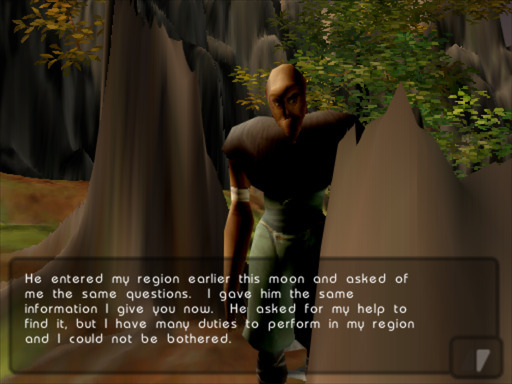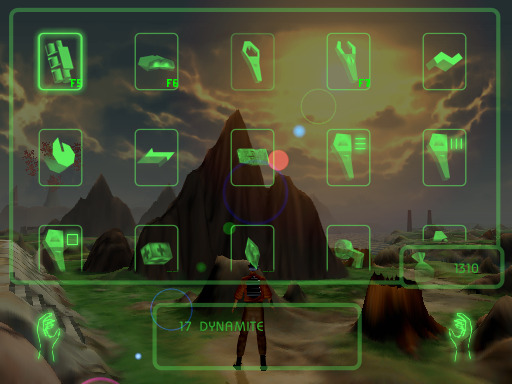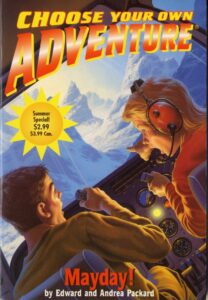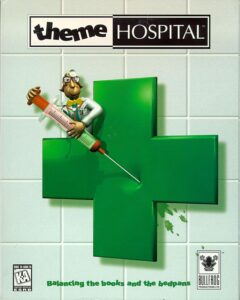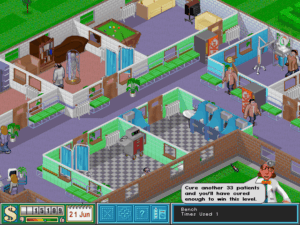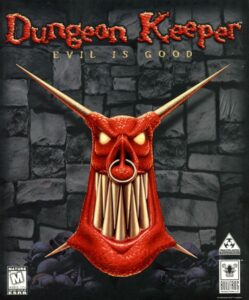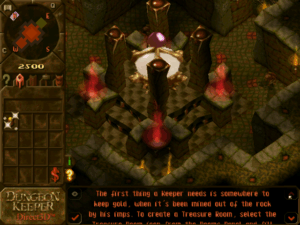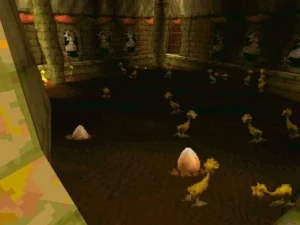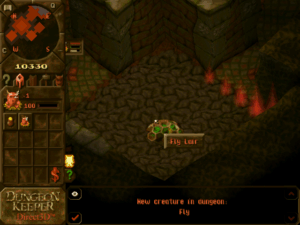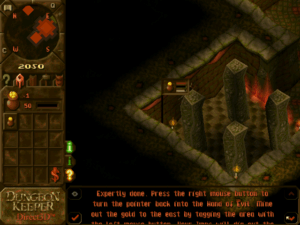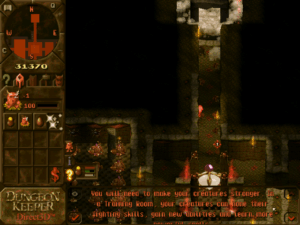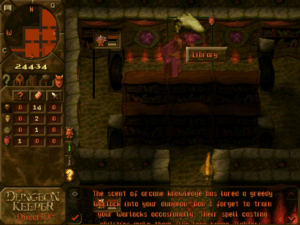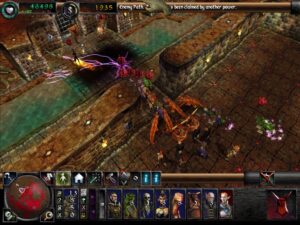There was some discussion about it: “Wow, gosh, it’d sure be nice if we were making more money and selling more copies so we could do crazy games of the type we want, as opposed to having to worry about how we’re going to sell more.” Hey, I’d love it if the public was more into what I like to do and a little less into slightly more straightforward things. But I totally get that they’re into straightforward things. I don’t have any divine right to have someone hand me millions of dollars to make a game of whatever I want to do. At some fundamental level, everyone has a wallet, and they vote with it.
— Doug Church, Looking Glass Studios
Late in 1994, after their rather brilliant game System Shock had debuted to a reception most kindly described as constrained, the Cambridge, Massachusetts-based studio Looking Glass Technologies sent their star producer Warren Spector down to Austin, Texas. There he was to visit the offices of Looking Glass’s publisher Origin Systems, whose lack of promotional enthusiasm they largely blamed for their latest game’s lukewarm commercial performance. Until recently, Spector had been directly employed by Origin. The thinking, then, was that he might still be able to pull some strings in Austin to move the games of Looking Glass a little higher up in the priority rankings. The upshot of his visit was not encouraging. “What do I have to do to get a hit around here?” Spector remembers pleading to his old colleagues. The answer was “very quiet, very calm: ‘Sign Mark Hamill to star in your game.‘ That was the thinking at the time.” But interactive movies were not at all what Looking Glass wanted to be doing, nor where they felt the long-term future of the games industry lay.
So, founders Paul Neurath and Ned Lerner decided to make some major changes in their business model in the hope of raising their studio’s profile. They accepted $3.8 million in venture capital and cut ties with Origin, announcing that henceforward Looking Glass would publish as well as create their games for themselves. Jerry Wolosenko, a new executive vice president whom they hired to help steer the company into its future of abundance, told The Boston Globe in May of 1995 that “we expect to do six original titles per year. We are just beginning.” This was an ambitious goal indeed for a studio that, in its five and a half years of existence to date, had managed to turn out just three original games alongside a handful of porting jobs.
Even more ambitious, if not brazen, was the product that Looking Glass thought would provide them with their entrée into the ranks of the big-time publishers. They intended to mount a head-on challenge to that noted tech monopolist Microsoft, whose venerable, archetypally entitled Flight Simulator was the last word — in fact, very nearly the only word — in civilian flight simulation. David-versus-Goliath contests in the business of media didn’t come much more pronounced than this one, but Looking Glass thought they had a strategy that might allow them to break at least this particular Microsoft monopoly.
Flight Unlimited was the brainchild of a high-energy physicist, glider pilot, and amateur jazz pianist named Seamus Blackley, who had arrived at Looking Glass by way of the legendary Fermi Laboratory. His guiding principle was that Microsoft’s Flight Simulator as it had evolved over the last decade and a half had become less a simulation of flight itself than a simulation of the humdrum routine of civil aviation — of takeoff permissions and holding patterns, of navigational transponders and instrument landing systems. He wanted to return the focus to the simple joy of soaring through the air in a flying machine, something that, for all the technological progress that had been made since the Wright brothers took off from Kitty Hawk, could still seem closer to magic than science. The emphasis would be on free-form aerobatics rather than getting from Airport A to Airport B. “I want people to see that flying is beautiful, exciting, and see the thrill you can get from six degrees of freedom when you control an airplane,” Blackley said. “That’s why we’ve focused on the experience of flying. There is no fuel gauge.”
The result really was oddly beautiful, being arguably as close to interactive art as a product that bills itself as a vehicular simulation can possibility get. Its only real concession to structure took the form of a 33-lesson flying course, which brought you from just being able to hold the airplane straight and level to executing gravity-denying Immelman rolls, Cuban eights, hammerheads, and inverted spins. Any time that your coursework became too intense, you always had the option to just bin the lesson plans and, you know, go out and fly, maybe to try some improvisational skywriting.
In one sense, Flight Unlimited was a dramatic departure from the two Ultima Underworld games and System Shock, all of which were embodied first-person, narrative-oriented designs that relied on 3D graphics of a very different stripe. In another sense, though, it was business as usual, another example of Looking Glass not only pushing boundaries of technology in a purist sense — the flight model of Flight Unlimited really was second to none — but using it in the service of a game that was equally aesthetically innovative, and just a little bit more thoughtful all the way around than was the norm.
Upon its release in May of 1995, Flight Unlimited garnered a rare five-stars-out-of-five review from Computer Gaming World magazine:
It’s just you, the sky, and a plane that does just about anything you ask it to. Anything aerobatic, that is. Flight Unlimited is missing many of the staple elements of flight simulations. There are no missiles, guns, or enemy aircraft. You can’t learn IFR navigation or practice for your cross-country solo. You can’t even land at a different airport than the one you took off from. But unless you’re just never happy without something to shoot at, you won’t care. You’ll be too busy choreographing aerial ballets, pulling off death-defying aerobatic stunts, or just enjoying a quiet soar down the ridge line to miss that stuff.
Flight Unlimited sold far better than System Shock: a third of a million copies, more even than Looking Glass’s previous best-seller Ultima Underworld, enough to put itself solidly in the black and justify a sequel. Still, it seems safe to say that it didn’t cause any sleepless nights for anyone at Microsoft. Over the years, Flight Simulator had become less a game than a whole cottage industry unto itself, filled with armchair pilots who often weren’t quite gamers in the conventional sense, who often played nothing else. It wasn’t all that easy to make inroads with a crowd such as that. Like a lot of Looking Glass’s games, Flight Unlimited was a fundamentally niche product to which was attached the burden of mainstream sales expectations.
That said, the fact remained that Flight Unlimited had made money for Looking Glass, which allowed them to continue to live the dream for a while longer. Neurath and Lerner sent a homesick Warren Spector back down to Austin to open a second branch there, to take advantage of an abundance of talent surrounding the University of Texas that the Wing Commander-addled Origin Systems was believed to be neglecting.
Then Looking Glass hit a wall. Its name was Terra Nova.
Terra Nova: Strike Force Centauri had had the most protracted development cycle of any Looking Glass game, dating almost all the way back to the very beginning of the company and passing through dozens of hands before it finally came to fruition in the spring of 1996. At its heart, it was an ultra-tactical first-person shooter vaguely inspired by the old Robert Heinlein novel Starship Troopers, tasking you with leading teams of fellow soldiers through a series of missions, clad in your high-tech combat gear that turned you more than halfway into a sentient robot. But it was also as close as Looking Glass would ever come to their own stab at a Wing Commander: the story was advanced via filmed cutscenes featuring real human actors, and a lot of attention was paid to the goings-on back at the ranch when you weren’t dressed up in your robot suit. This sort of thing worked in Wing Commander, to whatever extent it did, because the gameplay that took place between the movie segments was fairly quick and simple. Terra Nova was not like that, which could make it feel like an even more awkward mélange of chocolate and peanut butter. It’s difficult to say whether Activision’s Mechwarrior 2, the biggest computer game of 1995, helped it or hurt it in the marketplace: on the one hand, that game showed that there was a strong appetite for tactical combat involving robots, but, on the other, said demand was already being fed by a glut of copycats. Terra Nova got lost in the shuffle. A game that had been expected to sell at least half a million copies didn’t reach one-fifth of that total.
Looking Glass’s next game didn’t do any better. Like Flight Unlimited, British Open Championship Golf cut against the dark, gritty, and violent stereotype that tended to hold sway when people thought of Looking Glass, or for that matter of the games industry writ large. It was another direct challenge to an established behemoth: in this case, Access Software’s Links franchise, which, like Flight Simulator, had its own unique customer base, being the only line of boxed computer games that sold better to middle-aged corporate executives than they did to high-school and university students. Looking Glass’s golf project was led by one Rex Bradford, whose own history with simulating the sport went all the way back to Mean 18, a hit for Accolade in 1986. This time around, though, the upstart challenger to the status quo never even got a sniff. By way of damning with faint praise, Computer Gaming World called British Open Championship Golf “solid,” but “somewhat unspectacular.” Looking Glass could only wish that its sales could have been described in the same way.
With the benefit of hindsight, we can see all too clearly that Neurath and Lerner crossed the line that separates ambition from hubris when they decided to try to set Looking Glass up as a publisher. At the very time they were doing so, many another boutique publisher was doing the opposite, looking for a larger partner or purchaser to serve as shelter from the gale-force winds that were beginning to blow through the industry. More games were being made than ever, even as shelf space at retail wasn’t growing at anything like the same pace, and digital distribution for most types of games remained a nonstarter in an era in which almost everyone was still accessing the Internet via a slow, unstable dial-up connection. This turned the fight over retail space into a free-for-all worthy of the most ultra-violent beat-em-up. Sharp elbows alone weren’t enough to win at this game; you had to have deep pockets as well, had to either be a big publisher yourself or have one of them on your side. In deciding to strike out on their own, Neurath and Lerner may have been inspired by the story of Interplay Productions, a development studio which in 1988 had broken free of the grasp of Electronic Arts — now Origin System’s corporate parent, as it happened — and gone on to itself become one of the aforementioned big publishers who were increasingly dominating at retail. But 1988 had been a very different time in gaming.
In short, Neurath and Lerner had chosen just about the worst possible instant to try to seize full control of their own destiny. “Game distribution isn’t always based on quality,” noted Warren Spector at the end of 1996. Having thus stated the obvious, he elaborated:
The business has changed radically in the last year, and it’s depressing. The competition for shelf space is ridiculous and puts retailers in charge. If you don’t buy an end-cap from retailers for, say, $50,000 a month, they won’t buy many copies.
Products once had three to six months. The average life is now 30 days. If you’re not a hit in 30 days, you’re gone. This is predicated on your association with a publisher who gets your title on shelves. It’s a nightmare.
With just three games shipped in the last two and a half years — a long way off their projected pace of “six original titles per year” — and with the last two of them having flopped like a wet tuna on a gymnastics court, Looking Glass was now in dire straits. The only thing that had allowed them to keep the doors open this long had been a series of workaday porting jobs that Warren Spector had been relegated to supervising down in Austin, while he waited for the company to establish itself on a sound enough financial footing to support game development from whole cloth in both locations. Ten years on, after Looking Glass had been enshrined in gaming lore as one of the most forward-thinking studios of all time and Spector as the ultimate creative producer, the idea of them wasting their collective talents on anonymous console ports would seem surreal. But such was the reality circa 1997, when Looking Glass, having burnt through all of their venture capital, was left holding on by a thread. “I remember people walking into the office to take back the [rented] plants which the studio was no longer able to pay for,” says programmer and designer Randy Smith.
Ned Lerner abandoned what seemed to be a sinking ship, leaving Looking Glass to co-found a new studio called Multitude, whose focus was to be Internet-enabled multiplayer gaming. Meanwhile Neurath swallowed the hubris of 1995 and did what the managers of all independent games studios do when they find themselves unable to pay the bills anymore: looking for a buyer who would be able to pay them instead. But because Looking Glass could never seem to do anything in the conventional way even when they tried to, the buyer Neurath found was one of the strangest ever.
The Cambridge firm known as Intermetrics, Inc., was far from a household name, but it had a proud history that long predated the personal-computer era. Intermetrics had grown out of the fecund soil of Project Apollo, having been founded in March of 1969 by some of the engineers and programmers behind the Apollo Guidance Computer that would soon help to place astronauts on the Moon. After that epochal achievement, Intermetrics continued to do a lot of work for NASA, providing much of the software that was used to control the Space Shuttle. Other government and aerospace-industry contracts filled out most of the balance of its order sheets.
In August of 1995, however, a group of investors led by a television executive bought the firm for $28 million, with the intention of turning it into something altogether different. Michael Alexander came from the media conglomerate MCA, where he had been credited with turning around the fortunes of the cable-television channel USA. Witnessing the transformation that high-resolution graphics, high-quality sound, and the enormous storage capacity of CD-ROM were wreaking on personal computing, he had joined dozens of his peers in deciding that the future of mass-market entertainment and infotainment lay with interactive multimedia. Deeming most of the companies who were already in that space to be “overvalued,” and apparently assuming that one type of computer programming was more or less the same as any other, he bought Intermetrics, whose uniform of white shirts, ties, and crew cuts had changed little since the heyday of the Space Race, to ride the hottest wave in 1990s consumer electronics.
“This is a company that has the skills and expertise to be in the multimedia business, but is not perceived as being in that business,” he told a reporter from The Los Angeles Times. (It was not a question of perception; Intermetrics was not in the multimedia business prior to the acquisition.) “And that is its strength.” (He failed to elaborate on exactly why this should be the case.) Even the journalist to whom he spoke seemed skeptical. “Ponytailed, black-clad, twenty-something multimedia developers beware,” she wrote, almost palpably smirking between the lines. “Graying engineers with pocket protectors and a dozen years of experience are starting to compete.” Likewise, it is hard not to suspect Brian Fargo of Interplay of trolling the poor rube when he said that “I think it’s great that the defense guys are doing this. It’s where the job security is now. It used to be in defense. Now it’s in the videogame business.” (Through good times and bad, one thing the videogame business has never, ever been noted for is its job security.)
Alas, Michael Alexander was not just a bandwagon jumper; he was a late bandwagon jumper. By the time he bought Intermetrics, the multimedia bubble was already close to popping under the pressure of a more sustained Internet bubble that would end the era of the non-game multimedia CD-ROM almost before it had begun. As this harsh reality became clear in the months that followed, Alexander had no choice but to push Intermetrics more and more in the direction of games, the only kind of CD-ROM product that was making anyone any money. The culture clash that resulted was intractable, as pretty much anyone who knew anything about the various cultures of computing could have predicted. Among these someones was Mike Dornbrook, a games-industry stalwart who had gotten his start with Infocom in the early 1980s. Seeking his next gig after Boffo Games, a studio he had founded with his old Infocom colleague Steve Meretzky, went down in flames, Dornbrook briefly kicked the tires at Intermetrics, but quickly concluded that what he saw “made no sense whatsoever”: “They were mostly COBOL programmers in their fifties and sixties. I remember looking around and saying, ‘You’re going to turn these guys into game programmers? What in the world are you thinking?'” [1]Dornbrook wound up signing on with a tiny startup called Harmonix Music Systems, which in 2005, after years of diligent experimentation with the possibilities for combining music and games, altered the landscape of gaming forever with Guitar Hero.
Belatedly realizing that all types of programming were perhaps not quite so interchangeable as he had believed, Michael Alexander set out in search of youngsters to teach his old dogs some new tricks. The Intermetrics rank and file must have shuddered at the advertisements he started to run in gaming magazines. “We are rocket scientists!” the ads trumpeted. “Even our games are mission-critical!” When these efforts failed to surface a critical mass of game-development talent, Alexander reluctantly moved on to doing what he should have done back in 1995: looking for an extant studio that already knew how to make games. It so happened that Looking Glass was right there in Cambridge, and, thanks to its troubled circumstances, was not as “overvalued” as most of its peers. Any port in a storm, as they say.
On August 14, 1997, a joint press release was issued: “Intermetrics, Inc., a 28-year-old leading software developer, and Looking Glass Studios, one of the computer gaming industry’s foremost developers, today announce the merger of the two companies’ gaming operations to form Intermetrics/Looking Glass Studios, LLC. Through the shared strengths of the two entities, the new company is strategically positioned to be a major force in the computer-game, console and online-gaming industries.” Evidently on a quest to find out how much meaningless corporate-speak he could shoehorn into one document, Michael Alexander went on to add that “Looking Glass Studios immediately catapults Intermetrics into a leading position in the gaming industry by giving us additional credentials and assets to compete in the market. Our business plan is to maintain and grow our core contract-services business while at the same time leveraging our expertise and financial resources to be a major player in the booming interactive-entertainment industry.” The price paid by the rocket scientists for their second-stage booster has to my knowledge never been publicly revealed.
The acquiring party may have been weird as all get-out, but it could have worked out far worse for Looking Glass, all things considered. In addition to the obvious benefit of being able to keep the doors open, at least a couple of other really good things came directly out of the acquisition. One was a change in name, from Looking Glass Technologies to Looking Glass Studios, emphasizing the creative dimension of their work. Another was a distribution deal with Eidos, a British publisher that had serious retail clout in both North America and Europe. Riding high on the back of the massive international hit Tomb Raider, Eidos could ensure that Looking Glass’s games got prominent placement in stores. Meanwhile this idea of the Looking Glass people serving as mentors to those who were struggling to make games at Intermetrics proper — an excruciating proposition for both parties — would prove to mostly be a polite, face-saving fiction for Michael Alexander; in practice, the new parent company would prove largely content to leave its subsidiary alone to do its own thing. Now the folks at Looking Glass just needed to deliver a hit to firmly establish themselves in their new situation. That was always the sticky wicket for them.
The first game that Looking Glass released under their new ownership was Flight Unlimited II, which appeared just a few months after the big announcement. Created without the input of Seamus Blackley, who had left the company, Flight Unlimited II sought simultaneously to capitalize on the relative success of Looking Glass’s first flight simulator and to adjust that game’s priorities to better coincide with the real or perceived desires of the market. Looking Glass paired the extant flight model with an impressively detailed depiction of the geography of the San Francisco Bay Area. Then they added a lot more structure to the whole affair, in the form of a set of missions to fly after you finished your training. The biggest innovation, a first for any civilian flight simulator, was the addition of other aircraft, turning San Francisco International Airport into the same tangle of congested flight lanes it was in the real world. These changes moved the game away from being such a purist simulation of flight as an end unto itself. Still, there was a logic to the additions; one can easily imagine them making Flight Unlimited II more appealing to the sorts of gamers who don’t tend to thrive in goal-less sandboxes. Be that as it may, though, it didn’t show up in the sales figures. Flight Unlimited II sold better than Terra Nova or British Open Championship Golf, but not as well as its series predecessor, just barely managing to break even.
This disappointment put that much more pressure on Looking Glass’s next game to please the new boss and show that the studio could deliver a solid, unqualified hit. In a triumph of hope over experience, everyone had high expectations for The Dark Project, which had been described in the press release announcing the acquisition as “a next-generation fantasy role-playing game.” Such a description might have left gamers wondering if Looking Glass was returning to the territory of Ultima Underworld. As things worked out, the game that they would come to know as simply Thief would not be that at all, but would instead break new ground in a completely different way. It stands today alongside Ultima Underworld in another sense: as one of the three principal legs — the last one being System Shock, of course — that hold up Looking Glass’s towering modern-day reputation for relentless, high-concept innovation.
The off-kilter masterstroke that is Thief started with a new first-person 3D engine known as The Dark Engine. It could have powered a “low-brain shooter,” as the Looking Glass folks called the likes of the mega-hit Quake, with perfect equanimity. But they just couldn’t bring themselves to make one.
It took a goodly while for them to decide what they did want to do with The Dark Engine. Doug Church, the iconoclastic programmer and designer who had taken the leading role on System Shock, didn’t want to be out-front to the same extent on this project. The initial result of this lack of a strong authority figure was an awful lot of creative churn. There was talk of making a game called Better Red than Undead, mixing a Cold War-era spy caper with a zombie invasion. Almost as bizarre was Dark Camelot, an inverted Arthurian tale in which you played the Black Knight against King Arthur and his cronies, who were depicted as a bunch of insufferable holier-than-thou prigs. “Our marketing department wasn’t really into that one,” laughs Church.
Yet the core sensibility of that concept — of an amoral protagonist set against the corrupt establishment and all of its pretensions — is all over the game that did finally get made. Doug Church:
The missions [in Dark Camelot] that we had the best definition on and the best detail on were all breaking into Camelot, meeting up with someone, getting a clue, stealing something, whatever. As we did more work in that direction, and those continued to be the missions that we could explain best to other people, it just started going that way. Paul [Neurath] had been pushing for a while that the thief side of it was the really interesting part, and why not just do a thief game?
And as things got more chaotic and more stuff was going on and we were having more issues with how to market stuff, we just kept focusing on the thief part. We went through a bunch of different phases of reorganizing the project structure and a bunch of us got sucked into doing some other project work on Flight [Unlimited] and stuff, and there was all this chaos. We said, “Okay, well, we’ve got to get this going and really focus and make a plan.” So we put Greg [LoPiccolo] in charge of the project and we agreed we were going to call it Thief and we were going to focus much more. That’s when we went from lots of playing around and exploring to “let’s make this Thief game.”
It surely comes as no revelation to anyone reading this article that most game stories are power fantasies at bottom, in which you get to take on the identity of a larger-than-life protagonist who just keeps on growing stronger as you progress. Games which took a different approach were, although by no means unknown by the late 1990s, in the decided minority even outside of the testosterone-drenched ghetto of the first-person shooter. The most obvious exponents of the ordinary-mortal protagonist were to be found in the budding survival-horror genre, as pioneered by Alone in the Dark and its sequels on computers and Resident Evil on the consoles. But these games cast you as nearly powerless prey, being stalked through dark corridors by zombies and other things that go bump in the night. Thief makes you a stealthy predator, the unwanted visitor rifling through cupboards and striking without warning out of the darkness, yet most definitely not in any condition to mow down dozens of his enemies in full-frontal combat, Quake-style. If you’re indiscreet in your predations, you can become the cornered prey with head-snapping speed. This was something new at the time.
Or almost so. Coincidentally, two Japanese stealthy-predator games hit the Sony PlayStation in 1998, the same year as Thief’s release. Tenchu: Stealth Assassins cast you as a ninja, while Metal Gear Solid cast you as an agent of the American government on a top-secret commando mission. The latter in particular caused quite a stir, by combining its unusual gameplay style with the sort of operatically melodramatic storytelling that was more commonly associated with the JRPG genre. That said, Thief is a far more sophisticated affair than either of these games, in terms of both its gameplay and its fiction.
The titular thief and protagonist is a man known only as Garrett, who learned his trade on the streets of The City, a mixture of urban squalor and splendor that is best described as Renaissance Florence with magic — a welcome alternative to more typical fantasy settings. Over the course of a twelve-act campaign, Garrett is given a succession of increasingly daunting assignments, during which a larger plot that involves more than the acquisition of wealth by alternative methods does gradually take shape.
Although the mission tree is linear, nothing else about your experience in Thief is set in stone. It was extremely important to Looking Glass that Thief not turn into a puzzle game, a series of set-piece challenges with set-piece solutions. They wanted to offer up truly dynamic environments, environments that were in their own way every bit as much simulations as Flight Unlimited. They wanted to make you believe you were really in these spaces. Artist Daniel Thron speaks of the “deep sense of trust we had in the player. There isn’t a single solution to Thief. It’s up to you to figure out how to steal the thing. It’s letting you tell that story through gameplay. And that sense of ownership makes it unique. It becomes yours.” In the spirit of all that, the levels are big, with no clearly delineated through-line. These dynamic virtual spaces full of autonomous actors demand constant improvisation on your part even if you’ve explored them before.
Looking Glass understood that, in order for Thief to work as a vehicle for emergent narrative, all of the other actors on the stage have to respond believably to your actions. It’s a given that guards ought to hunt you down if you blatantly give away your presence to them. Thief distinguishes itself by the way it responds to more subtle stimuli. An ill-judged footstep on a creaky floor tile might cause a guard to stop and mutter to himself: “Wait! Did I just hear something?” Stand stock still and don’t make a sound, and maybe — maybe — he’ll shrug his shoulders and move on without bothering to investigate. If you do decide to take a shot at him with your trusty bow or blackjack, you best not miss, to steal a phrase from Omar Little. And you best hide the body carefully afterward, before one of his comrades comes wandering along the same corridor to stumble over it.
These types of situations and the split-second decisions they force upon you are the beating heart of Thief. Bringing them off was a massive technical challenge, one that made the creation of 3D-graphics engine itself seem like child’s play. The state of awareness of dozens of non-player characters had to be tracked, as did sound and proximity, light and shadow, to an extent that no shooter — no, not even Half-Life — had ever come close to doing before. Remarkably, Looking Glass largely pulled it off, whilst making sure that the more conventional parts of the engine worked equally well. Garrett’s three principal weapons — a blackjack for clubbing unsuspecting victims in the back of the head, a rapier for hand-to-hand combat, and a bow which can be used to shoot a variety of different types of arrows — are all immensely satisfying to use, having just the right feeling of weight in your virtual hands. The bow is a special delight: the arrows arc through the air exactly as one feels they ought to. You actually get to use your bow in all sorts of clever ways that go beyond killing, such as shooting water arrows to extinguish pesky torches — needless to say, darkness is your best friend and light your eternal enemy in this game — and firing rope arrows that serve Garrett as grappling hooks would a more conventional protagonist.
Looking Glass being Looking Glass, even the difficulty setting in Thief is more than it first appears to be. It’s wouldn’t be much of an exaggeration to say that Thief is really three games in one, depending on whether you play it on Normal, Hard, or Expert. (Looking Glass apparently wasn’t interested in the sorts of players who might be tempted by an “easy” mode.) Not only do the harder settings require you to collect more loot to score a passing grade on each mission, but the environments themselves become substantially larger. Most strikingly, in a brave subversion of the standard shooter formula, each successive difficulty setting requires you to kill fewer rather than more people; at the Expert level, you’re not allowed to kill anyone at all.
Regardless of the difficulty setting you choose, Thief will provide a stiff challenge. Its commitment to verisimilitude extends to all of its facets. In lieu of a conventional auto-map, it provides you only with whatever scribbled paper map Garrett has been able to scrounge from his co-conspirators, or sometimes not even that much. If your innate sense of direction isn’t great — mine certainly isn’t — you can spend a long time just trying to find your way in these big, twisty, murky spaces.
When it’s at its best, Thief is as amazing as it is uncompromising. It oozes atmosphere and tension; it’s the sort of game that demands to be played in a dark room behind a big monitor, with the phone shut off and a pair of headphones planted firmly over the ears. Sadly, though, it isn’t always this best version of itself. In comparison to Ultima Underworld or System Shock, both of which I enjoyed from first to last, Thief strikes me as a lumpy creation, a game of soaring highs but also some noteworthy lows. I was all-in during the first mission, a heist taking place in the mansion of a decadent nobleman. Having recently read Sarah Dunant’s The Birth of Venus and written quite a lot about Renaissance Florence, my receptors were well primed for this Neo-Renaissance setting. Then I came to the second mission, and suddenly I was being asked to fight my way through a bunch of zombies in an anonymous cave complex. Suddenly Thief felt like dozens of other first-person action games.
This odd schizophrenia persists throughout the game. The stealthy experience I’ve just been describing — the boldly innovative experience that everyone thinks of today when they think of Thief — is regularly interspersed with splatterfests against enemies who wouldn’t have been out of place in Quake: zombies, rat men, giant exploding frogs, for Pete’s sake. (Because these enemies aren’t human, they’re generally exempt from the prohibition against killing at the Expert level.) All told, it’s a jarring failure to stick to its guns from a studio that has gone down in gaming lore for refusing to sacrifice its artistic integrity, to its own great commercial detriment.
As happens so often in these cases, the reality behind the legend of Looking Glass is more nuanced. Almost to a person, the team who made Thief attribute the inconsistency in the level design to outside pressure, especially from their publisher Eidos, who had agreed to partially fund the project. “Eidos never believed in it and until the end told us to put in more monsters and have more fighting and exploring and less stealth, and I’m not sure there was ever a point [when] they got it,” claims Doug Church. “I mean, the trailers Eidos did for Thief were all scenes with people shooting fire arrows at people charging them. So you can derive from that how well they understood or believed in the idea.”
And yet one can make the ironic case that Eidos knew what they were doing when they pushed Looking Glass to play up the carnage a little more. Released in November of 1998, Thief finally garnered Looking Glass some sales figures that were almost commensurate with their positive reviews. (“If you’re tired of DOOM clones and hungry for challenge, give this fresh perspective a try,” said Computer Gaming World.) The game sold about half a million copies — not a huge hit by the standards of an id Software or Blizzard Entertainment, but by far the most copies Looking Glass had ever sold of anything. It gave them some much-needed positive cash flow, which allowed them to pay down some debts and to revel in some good vibes for a change when they looked at the bottom line. But most importantly for the people who had made Thief, its success gave them the runway they needed to make a sequel that would be more confident in its stealthy identity.
Did you enjoy this article? If so, please think about pitching in to help me make many more like it. You can pledge any amount you like.
Sources: The book Game Design Theory & Practice (2nd. ed.) by Richard Rouse III; Next Generation of March 1997 and June 1997; PC Zone of December 1998; Computer Gaming World of September 1995, June 1996, August 1997, April 1998, and March 1999; Retro Gamer 117, 177, and 260; Los Angeles Times of September 15 1995; Boston Globe of May 3 1995.
Online sources include the announcement of the Intermetrics acquisition on Looking Glass’s old website, InterMetrics’s own vintage website, “Ahead of Its Time: A History of Looking Glass” by Mike Mahardy at Polygon, and James Sterrett’s “Reasons for the Fall: A Post-Mortem on Looking Glass Studios.”
My special thanks to Ethan Johnson, a fellow gaming historian who knows a lot more about Looking Glass than I do, and set me straight on some important points after the first edition of this article was published.
Where to Get Them: Terra Nova: Strike Force Centauri and Thief Gold are available for digital purchase at GOG.com. The other Looking Glass games mentioned this article are unfortunately not.
Footnotes
| ↑1 | Dornbrook wound up signing on with a tiny startup called Harmonix Music Systems, which in 2005, after years of diligent experimentation with the possibilities for combining music and games, altered the landscape of gaming forever with Guitar Hero. |
|---|





